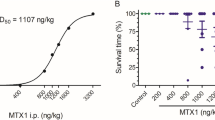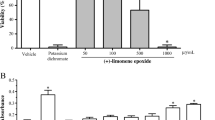Abstract
Ochratoxin A (OTA) a chlorodihydro-isocoumarin linked through an amide bond to phenylalanine, is a mycotoxin found as a contaminant in foodstuffs and shown to be nephrotoxic, teratogenic, immunosuppressive, genotoxic, mutagenic and carcinogenic in rodents. Ochratoxin A is known to induce teratogenic effects in neonates (rats and mice) exposed in utero, characterised by microcephaly and modification of the brain levels of free amino acids. Since OTA has been found to accumulate in the brain according to the duration of exposure to doses in the range of natural contamination of feedstuffs, experiments were designed to determine more precisely the structural target of OTA in the brain. After intracerebral injection, OTA (403 ng/10 μl) was not found in the following parts of the brain : the frontal cortex (FC), striatum (ST), ventral mesencephalon (VM) and the cerebellum (CB) in contrast to the rest of the brain, probably due to the detection limit of 0.1 ng/g of tissue. However lactate dehydrogenase (LDH) was increased in extracellular space in the VM to a greater extent than in the rest of the brain, indicating that this structure could be one of the targets of OTA in the brain. Contents of free amino acids were morever similarly modified in the VM and in the rest of the brain. Male rats were given OTA (289 μg/kg per 24 h) by gastric intubation for 8 days and the main brain structures analysed for OTA content and cytotoxicity. OTA was found in the following structures in decreasing order: rest of the brain (50.3%), cerebellum (34.4%), VM (5.1%), striatum (3.3%) and hippocampus (2.9%) of the total OTA amount found in the brain, which represents 0.022% to 0.028% of the given dose. Interestingly cytotoxicity as measured by lactate dehydrogenase (LDH) release in the extracellular space was much more pronounced in the VM, hippocampus, and striatum than in the cerebellum, whereas no cytotoxicity was observed in the rest of the brain. Similarly deoxyribonuclease (DNase) activity in relation to possible necrotic cells was increased in the VM and cerebellum. Altogether these results designated the ventral mesencephalon, hippocampus, striatum and cerebellum as the main OTA-targets in the brain of adult rats and excluded the rest of the brain.
Similar content being viewed by others
Author information
Authors and Affiliations
Additional information
Received: 2 April 1998 / Accepted: 28 April 1998
Rights and permissions
About this article
Cite this article
Belmadani, A., Tramu, G., Betbeder, A. et al. Regional selectivity to ochratoxin A, distribution and cytotoxicity in rat brain. Arch Toxicol 72, 656–662 (1998). https://doi.org/10.1007/s002040050557
Issue Date:
DOI: https://doi.org/10.1007/s002040050557




